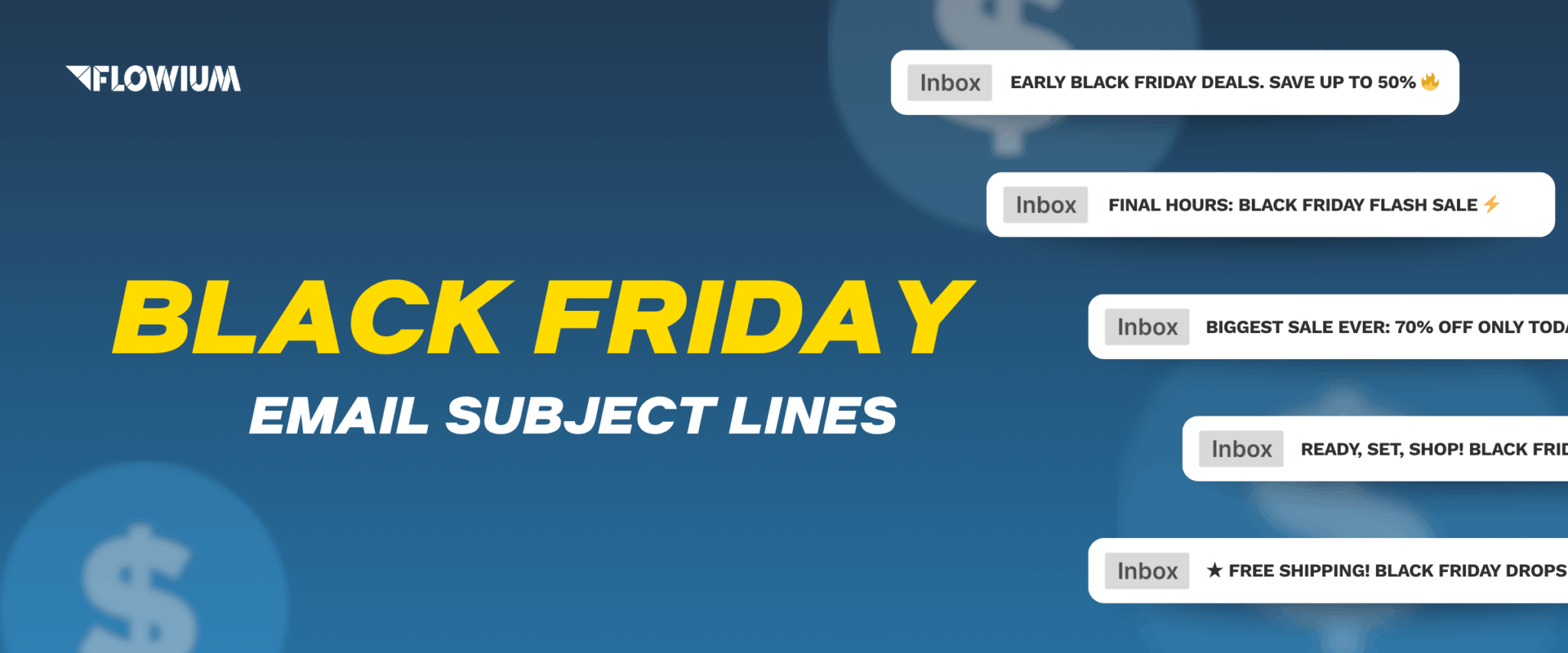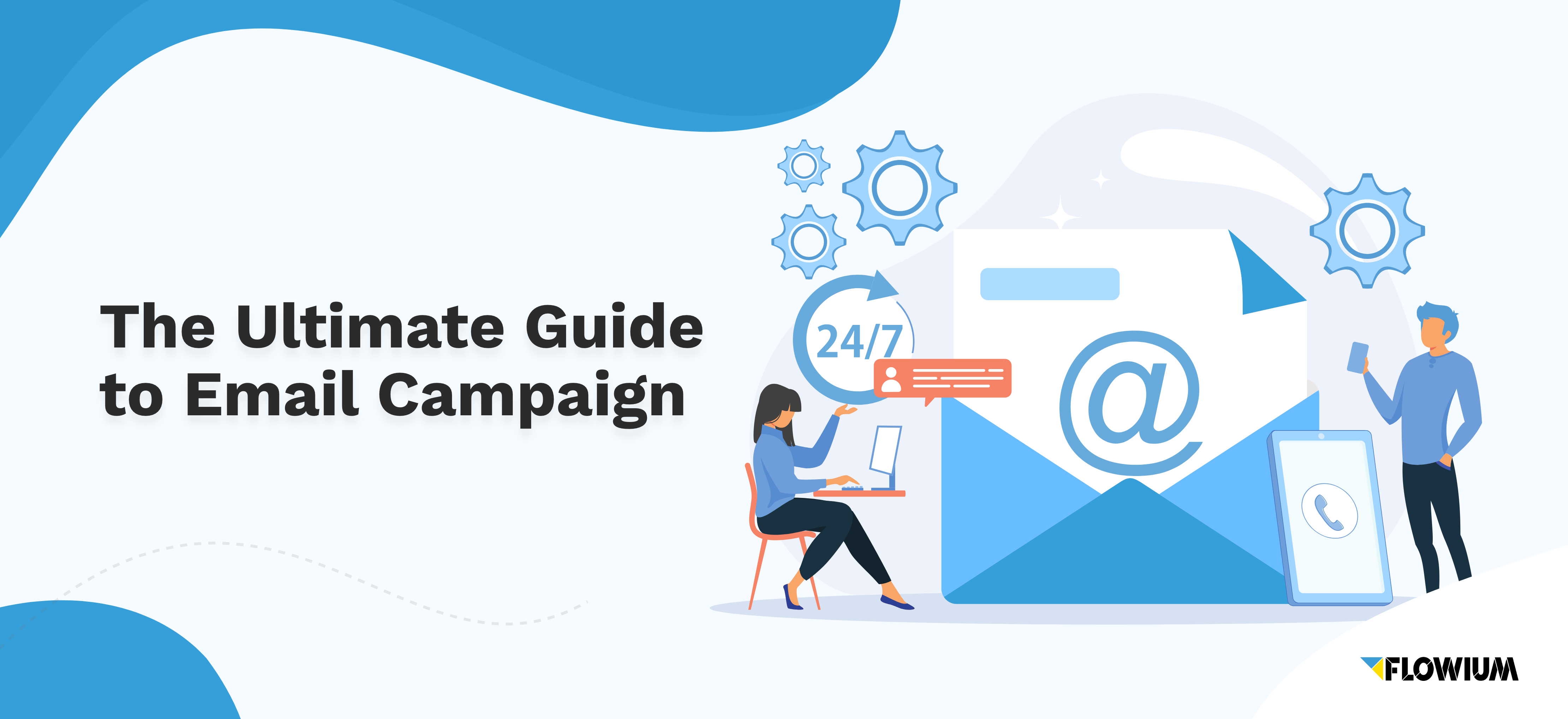Email marketing has been proven to be one of the best ways to market your eCommerce business. Emailing your customers helps establish a direct connection with them and build stronger relationships.
Modern email marketers have many strategies at their disposal, leading to highly granular campaigns that can target prospects more precisely than ever before.
One such strategy is email drip campaigns – a series of automated outreach campaigns triggered by a specific action your customer takes.
In this article, we’ll cover everything you need to know about email drip campaigns and how you can leverage them to promote your eCommerce business.
What is an Email Drip Campaign?
An email drip campaign is an email marketing tactic that uses a series of automated emails to guide your subscriber through the buying cycle. The “drip” part of a drip campaign simply means emails are sent out automatically over specific time intervals.
This series of automated emails – whether 3, 5, or whatever number you decide – starts when a customer takes a specific action, such as subscribing to your email list or adding products to their cart without buying.
💡 Drip campaigns can be used in eCommerce for a variety of purposes, such as lead generation, customer retention, and even customer onboarding. They’re often used alongside other digital marketing tactics like social media ads and retargeting pixels.
The ultimate goal of an email drip campaign in eCommerce is to stay top of mind with potential customers and encourage them to make a purchase.
By providing value through a series of helpful and informative emails, you can establish trust and credibility with your subscribers and increase the likelihood of them becoming loyal customers.
Automate your emails
Drip campaigns are an absolute timesaver thanks to their automated nature. You only set them up once and – if done correctly – reap the benefits on autopilot.
A drip campaign lets you send multiple emails to your subscribers without much effort. All you need is an email marketing software to set up a series of automated messages that will be sent automatically over time.
This means you won’t have to send each email manually and will be able to free up your time to focus on other important tasks.
Nurture your leads
Drip campaigns are a great way to build relationships with prospects and customers. They provide useful content that helps nurture your subscribers through the sales funnel — from awareness to purchase.
They allow you to keep in touch with all your customers, which wouldn’t be possible otherwise.
This can help you:
- Increase sales
- Reduce abandoned cart rates
- Recover lost customers.
For example, you can set up an abandoned cart drip campaign that starts when someone adds an item to their shopping cart but doesn’t buy it. This action will trigger a sequence of automated emails reminding them about the items they left in their cart and offering additional discounts.
Popular eCommerce Email Drip Campaign Examples
Incorporating email drip campaigns into your eCommerce marketing strategy is critical for driving sales and nurturing customer relationships.
To help you better understand the nature of email drip campaigns, we’ll share some of the most popular email drip campaign examples and how you can implement them into your eCommerce marketing efforts.
We will explore the various types of email drip campaigns that are effective in engaging with customers throughout the different stages of their journey with your eCommerce store.
Onboarding & welcome email drip campaign
A welcome email sequence is one of the best ways to let your subscribers know about your business.
You can set up welcome emails to be sent as soon as a user subscribes to your email list, creates an account on your website, or purchases your product for the first time.
- Try to be as specific as possible and provide links and landing pages so that they are redirected to your website.
- Remember to make a good first impression so that your customer gets interested and will want to return.
- Remember that the welcome email of the drip campaign is the first attempt to reach a customer.
- Do not put too much information in the email and make it simple and easy to read. You could even entice the subscriber with an exclusive offer.
Welcome email sequences are a great way to make an excellent first impression on new subscribers. They allow you to start the relationship on the right note and nurture it with each email.
Aside from building a relationship with your new prospects, the aim of a welcome email sequence is to guide your customers through the initial steps of their journey with you. It gives you room to introduce your brand, share your best products, and tell your customers exactly what they can expect from you.

Post-purchase email drip campaign
When a customer makes a purchase from your store, it’s an opportunity for you to nurture your relationship with them even further – and a post-purchase email drip campaign can help you do that.
Depending on your strategy, the aim of a post-purchase email sequence can be to:
- Thank your customer for their purchase
- Confirm their purchase and share detailed delivery information and tracking number, if relevant
- Upsell or cross-sell
- Invite them to join your loyalty program
- Ask them for a review.
It’s important to note that these aren’t mutually exclusive. A well-structured post-purchase drip campaign can effectively cover all of these areas. However, it’s important not to overdo it and overwhelm the customer with too much information.
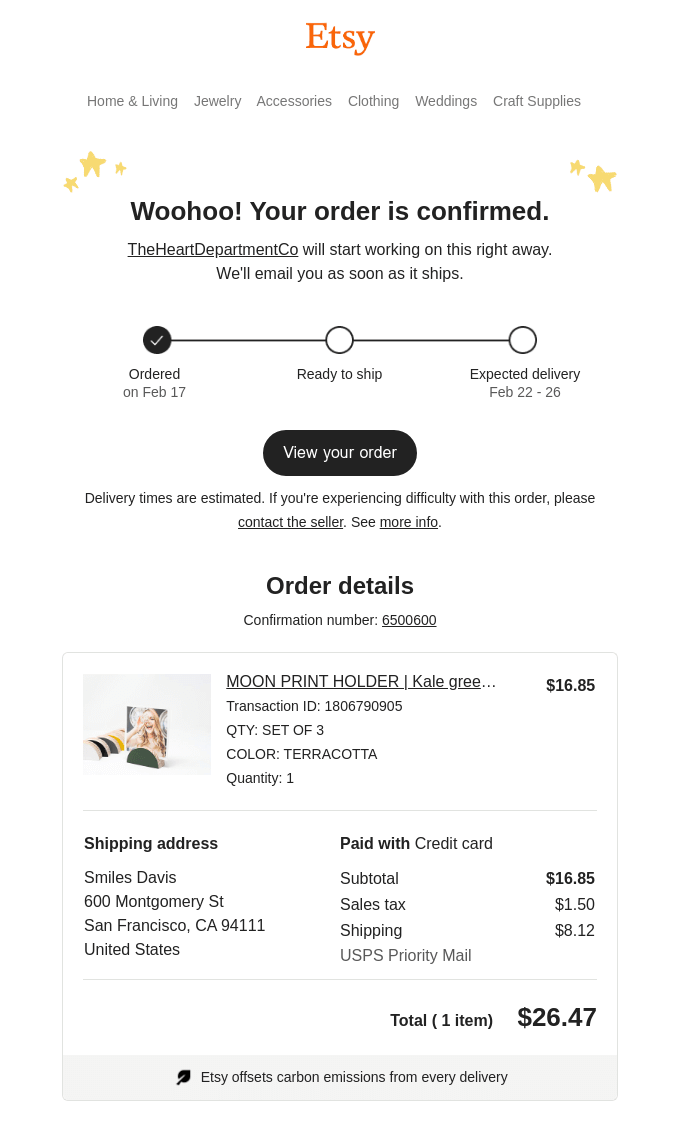
Abandoned cart drip campaigns
You should always react to abandoned carts quickly.
Many customers are actually expecting this.
In fact, some users are often only window shopping and add items to their carts to remember them in the future. But if you don’t set up an email drip campaign to remind them of these desired objects, would they come back by themselves?
Don’t miss any more opportunities, and set up email drip campaigns to make sure your potential customers receive automatic notifications of objects waiting for them.
This is also the perfect opportunity to suggest alternative products and convince hesitant visitors with product reviews and other social proof.

How to Set Up an Email Drip Campaign
The purpose of a drip campaign is to nurture leads through your sales funnel and engage them with relevant content at key points in the buying process.
A drip campaign can be set up in any email marketing platform, such as Mailchimp, Active Campaign, or Klaviyo.
Here are some practical steps to help you set up an email drip campaign effectively.
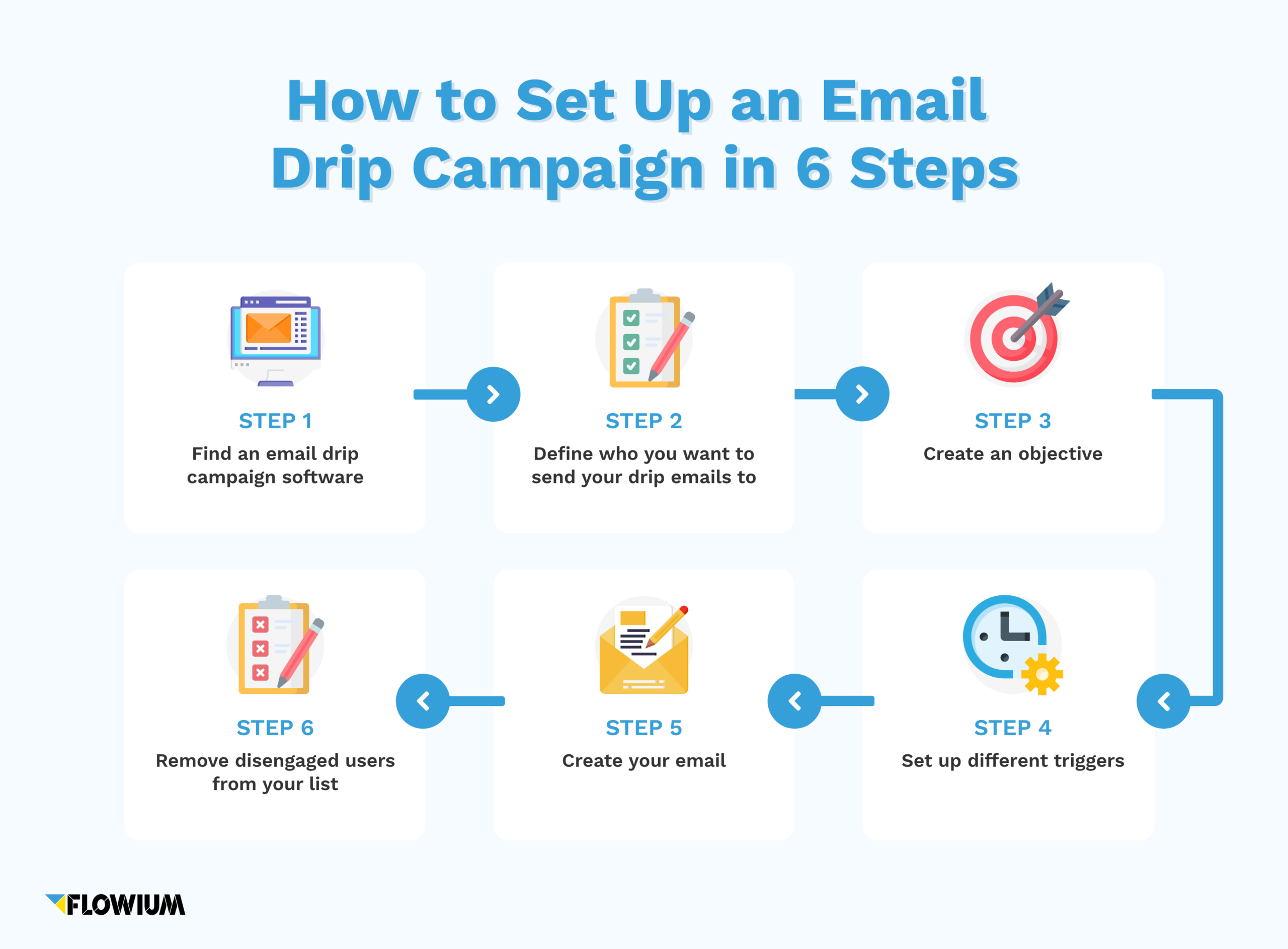
Find an email drip campaign software
The most important part of setting up your email drip campaigns is choosing an email marketing software that best suits your needs. Most of these platforms include drip campaigns as part of their service.
While there are many excellent email marketing tools on the market, our favorite is Klaviyo, which has been created specifically with eCommerce businesses in mind.
Klaviyo is a user-friendly platform with robust automation features that make it easy to create effective campaigns that drive sales. With Klaviyo, you can track customer behavior, segment your audience, and deliver personalized content that resonates with your customers.
Another excellent email marketing software for drip campaigns is Drip.
Drip is a fast-growing CRM designed specifically for the eCommerce industry and comes with the promise of helping eCommerce stores convert their leads into paying customers.
It’s an excellent tool targeted at eCommerce stores that have reached the stage where they see subscribers and website visitors in the thousands.
Define who you want to send your drip emails to
Drip campaigns can become complex as you add more conditions to the automation. Ensure that a customer does not receive too many emails, as this can become quite overwhelming.
Make sure you deliver the right message to the right segment of people. You can divide your target audience among the following:
- Those who have just signed up
- Those who have just made their first purchase
- Those who have downloaded your app
- And those who have subscribed to your newsletter
- Etc.
Create an objective
When it comes to marketing, you will need to be precise and rule out what your main goal is. Your objective could be one or more of the following:
- Lead nurturing
- Building a sales pitch
- Cross-selling or customer up-selling
- Or improving your customer experience.
Before you can launch your drip campaign, you must identify your goals, set up your triggers, decide how you are going to personalize the content, etc.
Set up different triggers
A trigger allows your automation system to work properly and sends specific emails to your subscribers.
When you use a drip campaign software, you can automatically send emails based on different triggers such as:
- When a person signs up
- When a subscriber submits a form
- Clicks on an internal link on your email
- Has an abandoned cart.
- Etc.
Example of email drip campaign scenarios:
- A user creates an account on your website, so you send them a welcome email.
- A user buys using a discount you offered and buys an item, so you thank him, then send them monthly emails about similar promotions and products.
- A user abandons their cart without buying the items, so you send him a reminder.
- A user stops reacting to your emails, even after re-engagement campaigns, so you notify him he is going to be removed from your email list.
Create your email
After you’ve set up your different triggers, create your email. No need to overthink this. Drip emails should usually be straightforward and concise.
Your welcome email sequence probably deserves more attention since first impressions matter the most. But for confirmation emails or shipping status updates, you can keep your messaging simple and strictly informative.
The most important thing is to stay on brand and to set up the right formulas to include abandoned cart items, product recommendations, personalized introductions, etc.
If you do not have the time to create your own email, you can always hire a professional to do so.
Remove disengaged users from your list
The last step towards setting up a successful drip campaign is to remove disengaged users from your email list.
Why? Because if they aren’t interested in what you offer, they’ll likely never convert into customers. They only add clutter to your list and lower your conversion rates.
It’s important to monitor the results of your email drip campaigns to figure out who engages with your campaigns and who doesn’t.
Most email marketing tools provide advanced reporting and analytics features that allow you to track metrics such as open rates, click-through rates, and conversion rates to understand how your campaigns are performing.
This data can help you optimize your campaigns, improve their effectiveness, and identify and remove unengaged subscribers.
Email Drip Campaign Best Practices
Email drip campaigns are a great way to build relationships with your customers and prospects, but they can be challenging to set up correctly.
If you’re not careful, you can end up sending too many emails and overwhelming your customer. Or, you can end up sending emails that aren’t well-targeted, causing your customers to unsubscribe.
To help you avoid potential issues, here are some of the best practices for creating effective email drip campaigns.
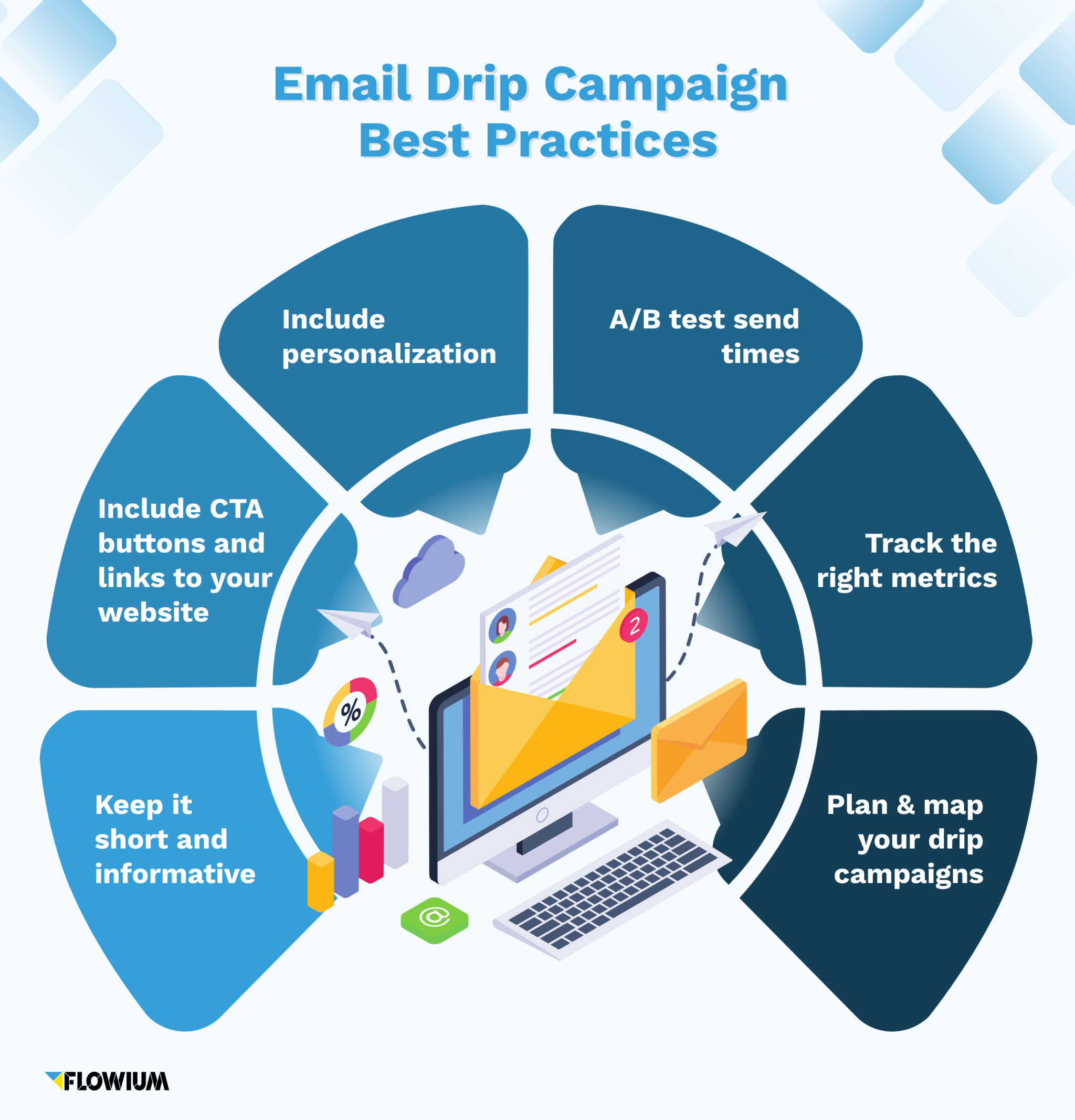
Keep it short and informative
Drip campaigns are an efficient way to keep your audience engaged and informed. The longer you can keep your subscribers in the loop, the more likely they are to engage with your content.
That being said, there is such a thing as too much information. If you send out emails that are too frequent or lengthy, you risk alienating your subscribers.
💡 While your welcome emails can be a bit more creative, in general, it’s best to keep your campaigns short, direct, and to the point. They should contain just enough information to convey your message without beating around the bush.
Include CTA buttons and links to your website
Drip campaigns are used in a variety of ways, but the goal is always the same: to increase sales by sending relevant messages at the right time.
To achieve that, you should let your subscribers know what you want them to do next. So, make sure to include strong CTAs in your email campaigns that direct people to the next step in their journey, whether it’s revisiting their abandoned cart or checking out a new product you just launched.
Aside from CTAs, you can also include links to your website or product integrations that take your subscribers straight to the product page.
💡 It’s important to remember not to overdo it, though. You don’t want to make your subscribers feel like you’re trying to push a sale or land in their spam inbox.
Include personalization
The key to successful drip campaigns is personalization and frequency.
According to research by McKinsey & Company, over 70% of consumers said that they expect to receive personalized campaigns from brands and even get upset when they don’t. That’s how powerful personalized email campaigns are!
Thanks to detailed user data and analytics, you can segment your subscribers based on the actions they’ve taken. It allows you to send more relevant messages that will resonate with each individual person.
💡 Personalization can include referring to your subscriber by their first name, offering products they might like based on their preferences, or including special deals based on their purchase history.
A/B test send times
The best way to identify what works best for your email drip campaigns is to test them. Most email marketing software includes A/B testing, which is a powerful feature to help you test things like send times, subject lines, and campaign content.
A/B test send times by sending multiple campaigns at different times of the day and see which performs best.
💡 You can also test your audience’s reaction times, for example, by sending an abandoned cart sequence one hour after the customer logs off your site.
Track the right metrics
If you want to get a clear picture of how effective your drip campaigns are, track the right metrics, such as your open rates, click-through rates, and click-to-open rates.
These three metrics are extremely important to monitor because they will help you determine how many people open or click on each email in the drip campaign, as well as how many people click on specific links within those emails.
You can then use this information to tweak your content and improve future campaigns.
Plan & map your drip campaigns
Before you set up your drip campaign, take time to plan it and map out how it will look like. Start by defining your objective. What do you want to achieve with this campaign?
Once you have a clear idea of your goal, it’s time to think about:
- What triggers will set off the campaign
- How many emails you want to send and at what time intervals
- What to talk about in each campaign
- How to segment your list
You can use an email marketing tools to create a visual flowchart of your drip campaign, which will help you visualize its overall structure and make the necessary adjustments.
Email Drip Campaign FAQs
A good rule of thumb is to keep your drip campaign between 3 and 5 emails. However, there is no one-size-fits-all rule. When creating your drip campaigns, use your better judgment to decide how many emails to include based on your audience’s engagement and your goal for the campaign.
The best way to create an email drip campaign is to use an email marketing software like Klaviyo. It will help you create a visual flowchart to map out your campaign by taking into account things like the number of emails, time intervals, and specific triggers.
Writing a drip email campaign can be challenging, especially if you are not a copywriter. Before writing one, determine the goal of your campaign and plan out the purpose and the content of each email.



